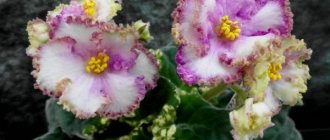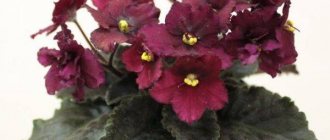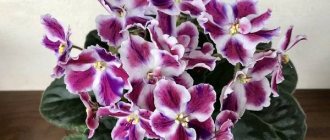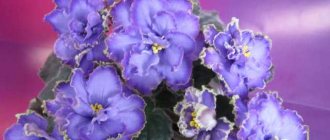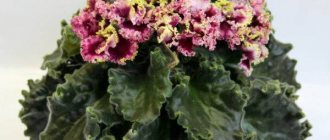The first specimens of the newly discovered Uzambara violet, which appeared at the world flower exhibitions more than a hundred years ago, won the hearts and minds of flower growers around the world with their delicate beauty, long flowering and relatively simple care in indoor cultivation.
Thanks to their beautiful appearance and ease of care, Saintpaulias quickly spread throughout home collections and took pride of place on shelves, racks and window sills.
Breeders immediately got involved in improving the varietal and decorative qualities of these tropical beauties.
Various breeding schools and private masters of breeding new varieties received various varieties and created entire lines under brand names.
But all these varieties were of interest mainly to enthusiastic flower growers and collectors who were ready to wait for a leaf from a violet they liked, nurture it into an adult plant, and then distribute the variety in the same leaf way.
Most lovers of beautiful violets did not want to endure such torment - it was easier to go to a flower boutique and purchase a ready-made copy of Saintpaulia for yourself or as a gift.
Industrial varieties were invented for this part of humanity . You can always find them in the store, they independently form an aligned rosette, bloom magnificently and for a long time.
But industrial varieties have important drawbacks: most of them are single flowering plants - you bought a violet, it bloomed and died.
Such varieties are very difficult to grow in home collections and cannot be propagated by leaf cuttings . Therefore, each gardener will have to make the choice of which violet to purchase for the collection - varietal or industrial. One of the groups of industrial varieties can be called Valeska violets.
Varieties of Valeska violets: Blue, Pink, Viol, Rosarot, Red (A. Fischer) are produced industrially in the German city of Hanover at a private enterprise for the creation and cultivation of Saintpaulias.
This company, one of the most significant and largest in the countries of the Old World, is headed by the master of selection Arnold Fischer. The company was founded in 1932, but the production of Saintpaulias began here in 1980.
IMPORTANT! Currently, A. Fischer’s company is the most powerful supplier of Uzambara violet babies to the world industrial Saintpaulia market.
Violet Valeska Blue
Saintpaulia from the industrial series . Selection by A. Fisher.
Photo of Valeska Blue violet.
Description
The violet independently forms a very aligned leaf rosette with a contour of a symmetrical configuration, classified according to the standard type .
The rosette is distinguished by its dense filling and beautiful arrangement of leaves on tiers - the leaf plates are fitted to each other, like a tiled roof structure.
leaves are distinguished by their small size, heart-shaped shape, clear venation pattern, smooth surface structure and color in the tone of summer greenery. The edge of the leaf blades has finely rounded serrations.
flowers , like a bouquet. The corollas are represented by pansies of considerable size and simple filling.
The main field of flowers has a white color, the lower three petals closer to the marginal edge bear large prints of a blue-bluish range, the two small upper segments remain unpainted.
ATTENTION! An important feature is the erect and strong peduncles, thanks to which the variety always has a chic bouquet above the rosette during flowering.
Sports
Violet is capable of occasionally forming sports with a variegated rosette and completely blue corollas. The variegation of the leaves decreases during the formation of buds; after the flowering phase, the light pattern is restored in all its glory.
Features of maintenance and care
For industrial varieties, violet is very finicky , despite the fact that it does not require the intervention of the grower in the process of forming a rosette.
When grown indoors, Saintpaulia forms buds quite late - a year after the baby takes root. It is almost impossible to propagate the variety at home.
The color intensity of blue spots fluctuates due to changes in temperature and light levels:
- a cool microclimate helps lighten the tone of the spots on the petals;
- At high temperatures, the corollas can turn completely blue.
ATTENTION! Due to low lighting, the violet appears blue. These properties should be taken into account when caring for it.
With a sufficient level of lighting, violets bloom without interruption, forming lush bouquets. Care should be taken to place the variety on the windowsill, since the plant loves the natural spectrum of light and will not want to bloom on a shelf.
Reviews
Gennady Viktorovich. “I have a very special relationship with the Valeska Blue variety - this is the first violet I bought. I’m surprised I had the strength to leave it after arriving from the store. But now we are friends with her, although she blooms extremely rarely.”
Ekaterina Pavlovna. “I accidentally came across a photo and description of the Valeska Blue violet on the Internet and I really liked it, so much so that I was eager to buy it. But a friend dissuaded me from buying it, saying that these varieties do not like to live long at home. I obeyed, but now I regret it.”
Growing and care
Placing Pots with Sunny Boy
In summer, violets will grow best on a northern or western windowsill. In winter, the south side is suitable for it, if there is insulation. If the windows and window sill are old, then it can be placed near the window, in addition to placing lighting fixtures. If the windowsill is cold, the pots can be placed on a wooden board, which will prevent the roots from freezing.
Attention! If the Sunny Boy violet gets cold, especially the root system, it will stop blooming.
Maintaining Humidity Levels
In conditions of natural growth, violets are more accustomed to humid air; a level of 50% must be maintained at home. To create humidity, the pot can be placed on a tray with pebbles or expanded clay watered with water, but on condition that the bowl itself does not touch the water.
During the heating season, you can resort to using a humidifier and wet towels placed on radiators.
Lighting for EK Sunny boy
The external condition of the plant improves if the light is diffused. Direct exposure to sunlight or close proximity of incandescent lamps can deteriorate the decorative appearance of violets. 10 hour illumination can be provided only with the help of special lamps.
Important! The leaves of any type of violet stretch towards the light, so they need to be turned in the other direction from time to time, so the rosette will be more symmetrical .
There is no need to illuminate the violet for more than 14 hours; it also needs dark time, otherwise the flowering period will shift and the leaves will not be so juicy.
Feeding the Sunny Boy
Indoor violets do not like very frequent fertilizers. This will ensure beautiful and dense flowering. If you buy soil for growing in a store, you do not need to feed the plant at first.
You can fertilize the Sunny Boy violet for the first time after flowering. It is better to use liquid complex fertilizers, but their concentration should be half that specified in the instructions. In the future, fertilization can be carried out in spring and autumn.
How to water a violet correctly
When watering a flower, the main thing is not to overdo it; wet soil can lead to the death of the plant. Most often, EK Sunny Boy is watered using the bottom method. To do this, fill the tray in which the pot is placed with water, and the soil can absorb moisture until the surface begins to shine.
If you water a plant from the top, you need to do it so that water does not get on its parts. It is best to use a watering can with a thin spout.
Interesting! One variety of violet can bloom differently depending on the conditions in which it is found. The intensity of the lemon shade can also change depending on the ambient temperature.
How to replant a violet
The size of the pot for EK Sunny Boy should be equal to 3 parts of the rosette. When the plants reach adult size, the volume of the pot can no longer be changed, but only renew the soil completely or partially.
What factors indicate the need for a transplant:
- the plant has stopped growing;
- the surface of the soil has acquired a whitish coating;
- the Sunny Boy violet has a trunk due to the removal of old leaves;
- the root system became cramped in a small pot.
Planting and replanting violets is best done in the spring, before the variety begins to bloom. A young plant that still needs an enlarged pot can be replanted with a ball of earth, adding new soil into the voids.
If there is a need to completely replace the soil, the roots must be cleaned very carefully, and do not try to remove absolutely all the soil if this does not work. It is enough to remove at least 70% of the total amount of soil.
Violet propagation
Sunny boy reproduces in the same way as other varieties of Saintpaulia.
to propagate violets using leaves , but there is a possibility of changes in varietal characteristics. The cut leaf is shortened slightly and dipped in water to form roots, usually this happens in the first 14 days. After this, the leaf can be rooted in a small pot until sprouts appear; it is covered with film or glass. With this method of propagation, the violet will bloom in the first year.
Stepchildren that form on the mother bush also take root well, but some of them acquire sports properties. You can root them immediately in the ground, or you can put them in water and wait for the roots.
Violet Valeska Pink
A variety produced industrially by 's breeding enterprise .
Photo of violet Valeska Pink.
Description
Saintpaulia independently forms a chic leaf rosette according to the standard type with a leveled contour, a good degree of fullness and a mosaic arrangement of leaves in tiers using the tiled technique.
The leaf blades are distinguished by the tonality of spring greenery with a salad venation pattern. The leaves are oblong-elongated in shape, have a quilted surface structure with a slight sheen and rounded-notched serration of the lateral edges.
The Valeska Pink violet blooms in a cap type with the formation of a large number of small pansy corollas of simple fullness.
The color of the buds corresponds to the classic standard of many Valeska varieties - large-diameter prints of a pinkish tint are distributed over the white background of the three lower petals, and the two upper petals are only slightly touched by pink strokes on the edge.
The peduncles of Saintpaulia are strong and straight, capable of supporting a large volume of buds.
Sports
in violets .
Features of maintenance and care
The varietal violet is completely unpretentious and is not fussy about its care in indoor cultivation. Varieties purchased from professional breeders can be recommended to beginning flower growers as adapted professional specimens.
ADVICE! Saintpaulia can bloom anywhere, but when placed on a windowsill it forms more accentuated prints on the flower petals, as it loves to bask in the rays of the natural spectrum.
As with all Valeska varieties, the color of the prints of the “Valeska Pink” variety depends on the temperature conditions of the room:
- if the buds were planted at elevated degrees, then their pink pattern will completely spread over the corolla;
- in cool conditions the flowers may turn almost white.
Reviews
Anna Nikolaevna. “For my birthday, I received Saintpaulia “Valeska Pink” as a gift from my colleagues. I’ve never grown indoor flowers, but suddenly I wanted to try it. But I chose the wrong variety - after flowering, my beauty began to wither, and I did not know how to help her. It’s good that the neighbor took the violet for herself and nursed it for a long time. Now I admire her when I’m visiting.”
Valentina. “By the color of the corollas, the “Valeska pink” violet can make a beautiful pair with the “Valeska blue” variety. If you plant several of them in one flowerpot, it will be a cool composition.”
My favorite nameless ones.
My collection, like probably everyone else’s, began with ringless ones. Some I grew from leaves, while others were bought in bloom from my grandmothers. Some pots had tags with the name of the variety, but at that moment I was not at all interested in them. Violets were bought for the soul and still make me happy.
This violet struck me at first sight. It was the first time I saw a green frill on a violet. It was simply a miracle. The violet was a varietal one, but the tag was lost due to uselessness. Much later I restored her name. This is most likely the Louisiana Lullaby variety.
Its rosette is large, spreading, but symmetrical. It is better to look at it from the side than from above, so it looks more harmonious. Its place is on the shelf at eye level. How can you not love her?
During spring flowering, the flower stalks were shorter and thicker. Now, the lack of light is probably affecting it. She stood on the window.
This violet suffered the most from mites last year. As a result, all that was left of it was a living root in the ground. New shoots grew on the stump, and only recently did it bloom. It is very similar to the Ambiance variety in both the color and shape of the leaves and flowers. When the bud opens, its shape is very similar to an apple tree flower. Her color is unimaginable, and not pink or beige, but some kind of golden. It is difficult to convey in words, and even more difficult in a photo.
And this is true retro. So ancient that even experts have forgotten its exact name. I grew up with such a violet back in the 90s. I really love beautiful and unusual leaves on plants. Violets also come with very beautiful foliage, which is also a delight between blooms. And gel foliage is the height of perfection. If a violet has gel leaves, then I don’t care how it blooms. Among my latest acquisitions I have a beautiful gel leaf, and a violet grown from it will most likely never bloom at all. But what a beautiful rosette it will be...
This is also most likely a retro variety. Violet is very similar to the Wedding Bells variety. I’ll show you a few photos of both the last flowering and the spring one. And if anyone has ever seen this variety live, please compare it with my photographs.
The next violet is an absolute nameless one. I couldn't find anything similar on the Internet. Cute, rather large roses with a lilac coating. In spring it bloomed lighter, but now the spraying is more pronounced. The leaf is pointed, light. If anyone can help identify her, I will be very glad.
This nameless flower has some translucent flowers, as if watery. They look very delicate and fragile.
Recently my first semi-mini Plumberry Glow bloomed, but unfortunately it was a sporty one. A small white spot in the center gives a ghostly hope for further proper flowering. But she’s even pretty athletic. And what a beautiful variegated foliage.
In conclusion, I want to show you my new flower stand. It is floor-standing, but after moving the shelves it fit on the window. Very comfortably.
Violet Valeska Rosarot
Industrial variety . Breeding luck of A. Fischer.
Photo of violet Valeska Rosarot.
Description
The violet forms a magnificent leaf rosette of the standard type with an absolutely even contour, fairly dense filling and the correct distribution of leaves in tiers using a mosaic technique.
The leaf blades are colored in a tone of lush green with lighter venation graphics. The leaves have a quilted surface structure, a light fleecy coating, a slightly wavy edge and an oblong-elongated configuration.
flowering occurs in a cap type with the formation of a huge number of medium-sized violet corollas of simple fullness. The flowers are given volume by a small fringe along the edge of the petals.
The coloring of the corollas follows the general standard of Valeska varieties - on the white field of the three lower petals large prints of dark shades of pink appear, on the upper two there are only small dark pink strokes along the edges.
Sports varieties
Violet Valeska Rosarot is not seen in the formation of sports.
Features of maintenance and care
Varietal violet belongs to a group of plants with easy care, early first flowering and abundant formation of children.
It is not particularly picky about lighting and location - it will bloom both on a shelf and on a windowsill. But in daylight, the buds form somewhat brighter.
The distribution of pink spots on the petals of the corollas depends entirely on temperature indicators:
- when flowering in the hot period, the corollas turn completely pink;
- the cool microclimate returns the white background to the petals.
It blooms up to 4 times a year with short rest breaks. Violet always forms a lush, foam-like cap of flowers; the decorative effect of the buds lasts for more than a month for each.
Reviews
Oleg Stepanovich. “I have long been interested in the varieties of A. Fisher’s company and chose the Valeska line. I'm putting together a collection. The “Valeska Rosarot” variety is my favorite - it blooms non-stop, is attractive and easy to propagate.”
Zinaida Vladimirovna. “For a long time, my family and friends scared me that there is no need to buy industrial varieties - they die quickly. But I bought the “Valeska Rosarot” variety from an experienced gardener. He assured that the violet had already been adapted. Indeed, Saintpaulia grows, blooms, multiplies, but I don’t know grief. She provided all her skeptics with children.”
Violet Valeska Viola
Saintpaulia belongs to the industrial line of A. Fischer varieties.
Photo of violet Valeska Viol.
Description
Saintpaulia independently forms a medium-sized rosette, classified according to the standard type. The bushes are invariably characterized by a leveled contour, a dense degree of fullness, attractive compactness and a beautiful pattern of leaves folded into a rosette.
In Saintpaulia, the leaf blades have a quilted surface structure, a rounded configuration, slight pubescence and finely jagged edges. The leaves are painted in the color of summer green with an emerald-colored venation pattern.
Flowering , like other varieties of Valeska, occurs according to the bouquet principle. The corollas, small in diameter, are collected in significant quantities, supported by strong peduncles, due to which a multi-colored fluffy volume is formed.
The flowers of this variety are distinguished by the fact that they are absolutely simple pansies with an even contour of the petals - not even a hint of waviness is allowed in the variety .
The coloring is traditional for Valeska varieties - the same three-dimensional prints on a white background of the three lower petals, the same two upper petals in white color. The only difference is in the color of the prints - they have different shades of lilac-violet with transitions to fuchsia colors.
Sports
Violet Valeska Viol can occasionally go into sports , characterized by a variegated rosette and an almost completely violet-colored corolla.
Features of maintenance and care
Violet is also a representative of problem-free Saintpaulias : it forms a rosette itself, produces an early first flowering and then produces large volumes of flowers that retain their decorative appearance for up to 2 months.
The colored spots on the petals depend entirely on the temperature of the room:
- at high temperatures, fuchsia spots merge into one colored background on flower petals;
- at low levels, the corollas may become completely white.
Reviews
Ellina. “I purchased a violet of the “Valeska Viola” variety that had not yet bloomed, and cared for it to the best of my ability and knowledge about the life processes of Saintpaulia. I waited so long for the emerging buds to open their leaves. And after all this, my sport blossomed. Not a white flower with charming spots of fuchsia, but a purple corolla against a background of variegated foliage, which I did not pay attention to at first. But upon closer inspection, it is also beautiful in its own way.”
Yulia Innokentievna. “I collect varieties from the Valeska line, they are so cute and defenseless. But there is no violet “Valeska Viola” yet. I’m looking for where to buy, the variety is on my wish list.”
Problems in growing
Important! Under no circumstances should you spray the Sunny Boy violet. The leaves have fine hair that can retain water and increase the risk of fungus. Spraying violets is even more undesirable in the cold season.
An indoor violet flower may deteriorate due to disease or pests. To avoid this, preventative treatment can be carried out. If EK Sunny Boy has any diseases, the pot with the plant must be separated from all the others to avoid further infection.
The presence of any diseases or pests will be noticeable by the condition of the leaves, which may become stained, moldy, turn black, or dry out. If the root system becomes diseased, a little later it will still appear on the upper part of the plant.
By growing the Sunny Boy violet at home and following the recommendations, you can observe for a long time the presence of flowers with a very unusual color, which is not typical of all varieties. Caring for violets requires a certain amount of care, but with experience everything is done automatically.
Violet Valeska Red
Represents the industrial line of breeder A. Fischer.
Photo of violet Valeska Red.
Description
Violet independently forms an aligned leaf rosette of the standard type with relatively dense filling and neat contour alignment. Saintpaulia bushes are distinguished by their beautiful arrangement of leaves in a rosette and compact shape.
Violet leaf blades have an oval-elongated configuration, a color of spring freshness, set off by a clear emerald venation pattern, a quilted-shiny surface structure and a smooth, slightly wavy lateral edge.
blooms in a bouquet type, forming medium-sized white corollas with extensive prints of raspberry-cranberry tones.
Sports
The plant did not detect sports.
Features of maintenance and care
Valeska Red violet is an unpretentious representative of the Valeska line, characterized by its easy-care nature, fast growth, compact rosette and long flowering.
Can be recommended for purchase by beginners in violet breeding. But it is better to purchase industrial varieties from trusted breeders, rather than in a store. The breeder has most likely already adapted the variety and will grow successfully in indoor cultivation for a long time.
The prints are located along the edges of all petals, merging into a single tone of the entire corolla at high temperatures. After the temperature normalizes, the corolla returns to its varietal coloring and decorativeness.
Reviews
Stanislav Petrovich. “For my taste, Saintpaulia “Valeska Red” is the most exquisite variety from this line. Captivates with its unpretentiousness and shades of petals.”
Olga Maksimovna. “In my collection, “Valeska Red” bloomed in the thick of it - the flowers turned out to be a terribly dark shade. I thought that I had lost the violet, but after the temperature dropped, it returned to its original color. Amazing flower."
